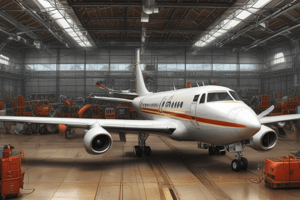Podcast
Questions and Answers
What is the primary purpose of airworthiness?
What is the primary purpose of airworthiness?
- To increase the aircraft's speed and performance
- To confirm the aircraft's compliance with safety standards and regulations (correct)
- To ensure the aircraft is aesthetically pleasing
- To reduce the operating costs of the aircraft
What is the outcome of regular and thorough maintenance?
What is the outcome of regular and thorough maintenance?
- The aircraft's speed and performance increase
- The aircraft's safety is compromised
- Every system and component of the aircraft functions correctly (correct)
- The aircraft becomes obsolete
What is the purpose of inspections in maintaining airworthiness?
What is the purpose of inspections in maintaining airworthiness?
- To increase the downtime of the aircraft
- To discover and rectify potential issues before they escalate into safety hazards (correct)
- To promote aircraft modification
- To reduce the budget for maintenance
What is the responsibility of every aircraft operator regarding airworthiness?
What is the responsibility of every aircraft operator regarding airworthiness?
What is the dynamic state that requires ongoing attention and action?
What is the dynamic state that requires ongoing attention and action?
What is the outcome of diligent maintenance and inspections?
What is the outcome of diligent maintenance and inspections?
What is the relationship between maintenance and inspection in airworthiness?
What is the relationship between maintenance and inspection in airworthiness?
What is the ultimate goal of maintaining airworthiness?
What is the ultimate goal of maintaining airworthiness?
What does airworthiness reflect?
What does airworthiness reflect?
What is the outcome of neglecting airworthiness requirements?
What is the outcome of neglecting airworthiness requirements?
Airworthiness is a one-time certification that does not require ongoing attention.
Airworthiness is a one-time certification that does not require ongoing attention.
The primary goal of airworthiness is to reduce the cost of maintenance.
The primary goal of airworthiness is to reduce the cost of maintenance.
Inspections are only necessary when there is a mechanical failure.
Inspections are only necessary when there is a mechanical failure.
Aircraft operators are not responsible for understanding airworthiness requirements.
Aircraft operators are not responsible for understanding airworthiness requirements.
Airworthiness only applies to commercial aircraft.
Airworthiness only applies to commercial aircraft.
Regular maintenance can eliminate the need for inspections.
Regular maintenance can eliminate the need for inspections.
Airworthiness is only concerned with the aircraft's physical condition.
Airworthiness is only concerned with the aircraft's physical condition.
The purpose of airworthiness is to maximize aircraft performance.
The purpose of airworthiness is to maximize aircraft performance.
Airworthiness is a static state that does not change over time.
Airworthiness is a static state that does not change over time.
Neglecting airworthiness requirements will not have any safety consequences.
Neglecting airworthiness requirements will not have any safety consequences.
What is the underlying assumption in considering airworthiness as a dynamic state?
What is the underlying assumption in considering airworthiness as a dynamic state?
What is the primary effect of mechanical failure on airworthiness?
What is the primary effect of mechanical failure on airworthiness?
What is the relationship between maintenance, inspections, and airworthiness?
What is the relationship between maintenance, inspections, and airworthiness?
How do inspections contribute to airworthiness?
How do inspections contribute to airworthiness?
What is the ultimate goal of maintaining airworthiness?
What is the ultimate goal of maintaining airworthiness?
What is the consequence of neglecting airworthiness requirements?
What is the consequence of neglecting airworthiness requirements?
What is the role of aircraft operators in maintaining airworthiness?
What is the role of aircraft operators in maintaining airworthiness?
How does regular and thorough maintenance impact airworthiness?
How does regular and thorough maintenance impact airworthiness?
What is the significance of certifications in airworthiness?
What is the significance of certifications in airworthiness?
What is the relationship between airworthiness and safety?
What is the relationship between airworthiness and safety?
Flashcards are hidden until you start studying
Study Notes
Maintenance, Safety, and Airworthiness
- Maintenance is a broad range of activities, including routine inspections, repairs, and replacement of worn or defective components, aimed at ensuring aircraft are in optimal condition for safe operation.
- Specific maintenance requirements under 14 CFR part 91 include adherence to manufacturer's maintenance schedule, prompt attention to defects or malfunctions, and compliance with Airworthiness Directives (ADs).
Airworthiness Certificates
- An airworthiness certificate is issued by the Federal Aviation Administration (FAA) and indicates that an aircraft is safe for flight according to FAA standards.
- The certificate is a legal requirement for flying, and operating without one can result in fines or compromised safety.
- There are two primary types of airworthiness certificates: standard (for most general and commercial aviation aircraft) and special (for unique or limited operations like experimental or light sport aircraft).
Importance of Airworthiness Certificates
- Airworthiness certificates are critical in aircraft sales and transfers, as an expired or missing certificate can halt the sale process.
- Obtaining and renewing an airworthiness certificate involves stringent inspection processes, ensuring the aircraft adheres to safety standards throughout its operational life.
- Pilots must ensure that the airworthiness certificate is present and valid before every takeoff.
Safety Procedures and Performance
- The Performance section of the Flight Manual is a crucial component that informs and safeguards flight operations.
- It provides critical data such as takeoff and landing distances, fuel consumption rates, climb performance, and more, which directly relates to safety and aircraft capabilities.
- Understanding the Performance section is essential for pre-flight planning and in-flight adjustments, ensuring that safety is a constant practice.
Maintenance, Inspections, and Airworthiness
- Regular and thorough maintenance ensures that every system and component of the aircraft functions correctly, reducing the risk of incidents or accidents due to mechanical failure.
- Inspections act as a systematic approach to discover and rectify potential issues before they escalate into safety hazards.
- Maintenance and inspections form the bedrock of aircraft airworthiness, making them indispensable in the pursuit of a safe and reliable aviation environment.
Foundations of Flight: Understanding FAA Documentation and Procedures
- An airworthiness certificate is a seal of approval from the Federal Aviation Administration (FAA) indicating an aircraft is safe for flight according to the agency's rigorous standards.
- The certificate is a testament to the aircraft's fitness, signaling it meets both design and condition requirements for safe operation.
- Without a valid airworthiness certificate, an aircraft is grounded, both literally and legally.
Types of Airworthiness Certificates
- The FAA issues two primary types: standard and special.
- Standard airworthiness certificates cover most general and commercial aviation aircraft.
- Special airworthiness certificates are reserved for unique or limited operations like experimental or light sport aircraft.
Importance of Airworthiness Certificates
- A valid airworthiness certificate is crucial for aircraft sales and transfers.
- Obtaining and renewing an airworthiness certificate involves stringent inspection processes known as airworthiness directives.
- Operating without a valid airworthiness certificate can result in hefty fines or compromised safety.
Pilot Responsibility
- Pilots must ensure the airworthiness certificate is present and valid before every takeoff.
- It's a critical pre-flight checklist item that should never be overlooked.
Safety Procedures and Performance
- The Performance section of the Flight Manual is a critical component of pre-flight planning and active in-flight adjustments.
- It enumerates critical data such as takeoff and landing distances, fuel consumption rates, climb performance, and more.
- Every calculation relates directly back to safety and the aircraft's capabilities.
Interpreting Performance Data
- Accurately interpreting Performance section data enables precise journey planning and safe execution of the flight.
- Weather conditions, runway lengths, weight and balance are all factors that impact Performance section data.
FAA Regulations and Inoperative Equipment
- The FAA provides guidance on safety operations and aircraft performance parameters in cases of inoperative equipment.
- Performance margins serve as a buffer zone, keeping pilots safe in the face of unexpected conditions.
Flexibility in Planning
- Safety demands flexibility in the planning stage, adapting to limitations outlined in the Performance section.
Importance of the Performance Section
- The Performance section is a critical tool for maintaining peak safety standards.
- It's formulated data transformed into pilot action, and pilots trust it with every mile flown.
Maintenance and Inspection Requirements
- Maintenance, as defined by 14 CFR part 91, includes routine inspections, repairs, and replacement of worn or defective components to ensure aircraft are in optimal condition for safe operation.
- Specific maintenance requirements under 14 CFR part 91 include regular upkeep according to the manufacturer's schedule, prompt attention to defects or malfunctions, and compliance with all applicable Airworthiness Directives (ADs).
- Airworthiness Directives (ADs) are issued by the Federal Aviation Administration (FAA) when a safety issue requires immediate action.
Types of Inspections
- Inspections are conducted on a regular basis and are divided into different types depending on the aircraft and its usage.
- Commonly known inspections include the annual inspection, which is mandatory for all aircraft, and the 100-hour inspection, which is pertinent for aircraft used for hire or flight instruction.
- Each type of inspection has a specific scope and depth, with the goal of detecting any issues that could compromise the airworthiness of the aircraft.
Airworthiness Certificates
- An airworthiness certificate is issued by the Federal Aviation Administration (FAA) and indicates that an aircraft is safe for flight according to the agency's rigorous standards.
- The certificate is a testament to the aircraft's fitness, signaling that it meets both the design and condition requirements for safe operation.
- The FAA issues two primary types of airworthiness certificates: standard and special.
Importances of Airworthiness Certificates
- Without a valid airworthiness certificate, an aircraft is grounded, both literally and legally.
- It's crucial for every pilot to know their craft's type and adhere to its specific regulations.
Performance Section of the Flight Manual
- The Performance section is the cornerstone that holds up the framework of pre-flight planning and active in-flight adjustments.
- It enumerates critical data such as takeoff and landing distances, fuel consumption rates, climb performance, and much more.
- Every calculation relates directly back to safety and the aircraft's capabilities.
Importance of Understanding Performance Data
- Understanding the Performance section is paramount to assuring that safety is not just a concept, but a constant practice.
- The section is not just a feature of the manual, but a co-pilot in critical decision-making.
Safety Procedures and Performance
- The Performance section guides pilots in planning and executing flights safely, considering factors such as weather conditions, runway lengths, weight, and balance.
- It provides a buffer zone, or performance margins, to keep pilots safe in the face of unexpected conditions.
- The section emphasizes flexibility in planning, as safety demands adapting to changing variables.
Connection between Safety and Airworthiness
- Airworthiness is not only a confirmation of an aircraft's suitability for flight but also a legal certification that the aircraft complies with all safety standards and regulations.
- It reflects a commitment to the highest safety standards and is a dynamic state, requiring ongoing attention and action.
- Regular and thorough maintenance ensures that every system and component of the aircraft functions correctly, upholding airworthiness and reducing the risk of incidents or accidents due to mechanical failure.
Studying That Suits You
Use AI to generate personalized quizzes and flashcards to suit your learning preferences.




